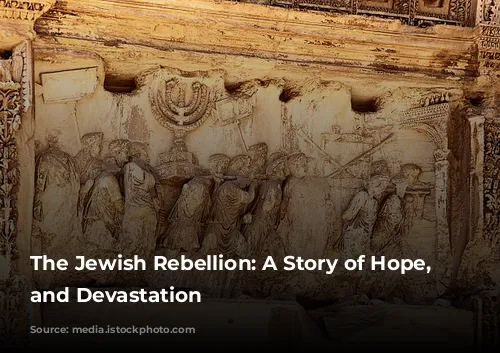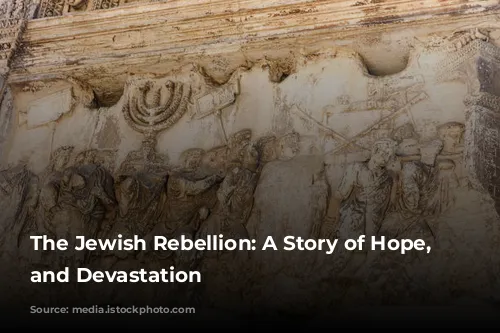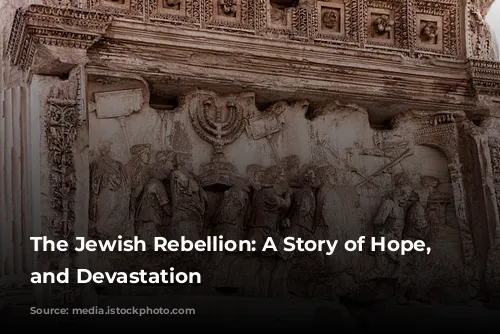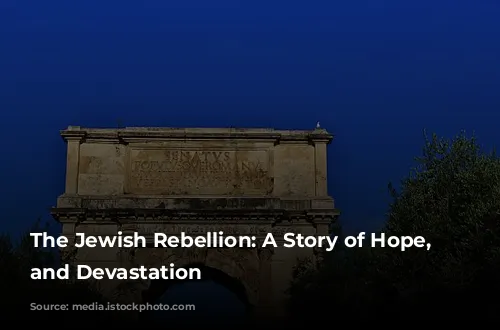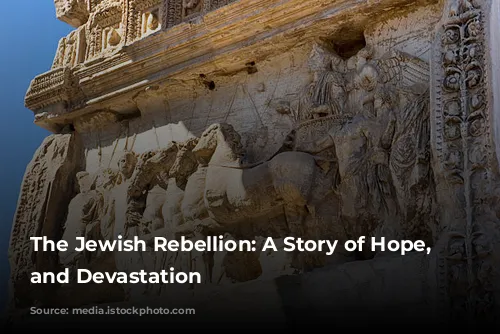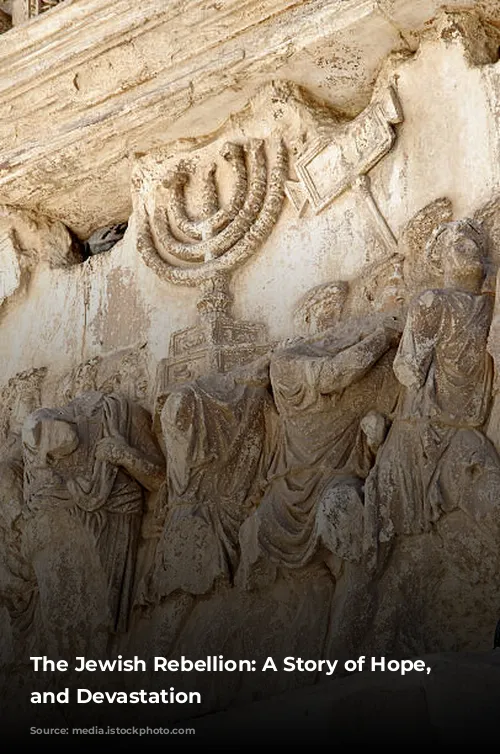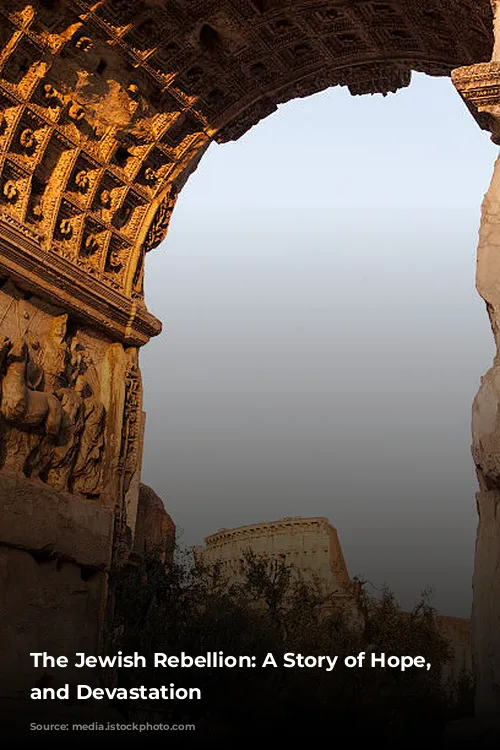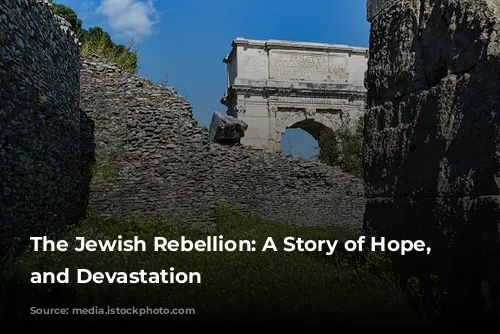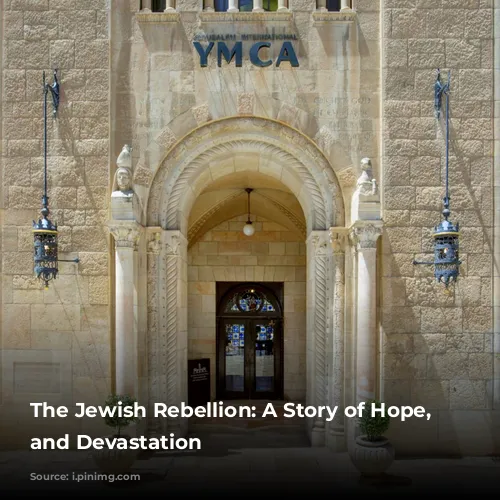In the year 70 AD, the Roman Empire’s presence in Judea, the land of the Jews, reached a boiling point. The story of the Jewish rebellion that ultimately led to the destruction of Jerusalem is a tragic tale of hope, division, and devastation. It is a story told through the lens of ancient reports, most notably the writings of Josephus, a Jewish general captured by the Romans who became a chronicler of the war.
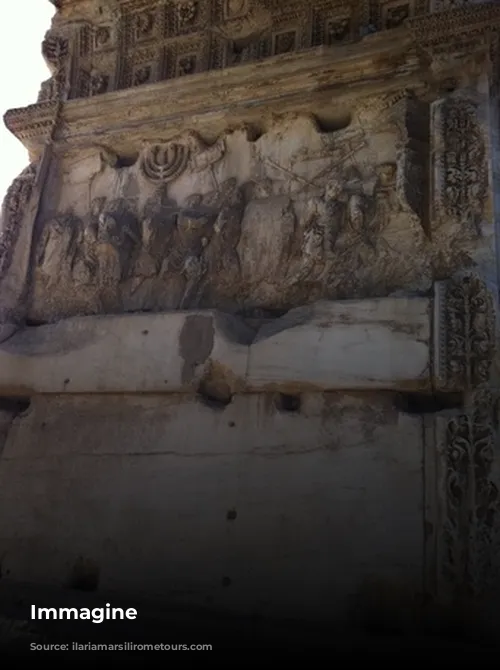
Seeds of Rebellion: An Unstable Peace
The flames of rebellion were ignited by the actions of Gessius Florus, the Roman governor of Judea. In May 66 AD, he sent his troops to Jerusalem’s bustling marketplace with brutal orders: kill everyone in sight. The resulting bloodshed, claiming the lives of over 3,600 men, women, and children, shocked the Jewish populace. This brutal act of violence fueled a burgeoning rebellion against Roman rule.
Amidst this rising unrest, there was a desperate attempt at peace. Agrippa II, a Jewish prince appointed by the Romans, tried to quell the rising anger. However, the seeds of rebellion had already taken root, and the moderate voices advocating for peace were drowned out by the growing tide of resistance.
The Jewish people were divided. On one side stood the war party, fueled by a desire for independence from Roman control. On the other, the peace party, clinging to the hope of a negotiated settlement. This deep schism within the Jewish community would ultimately contribute to their downfall.
The rebellion was further fueled by a defiant act of defiance by the Jewish priest, Eleazar. He forbade the offering of sacrifices paid by strangers, a longstanding custom that demonstrated loyalty to the Roman Empire. This act, according to Josephus, effectively ignited the conflict with Rome.
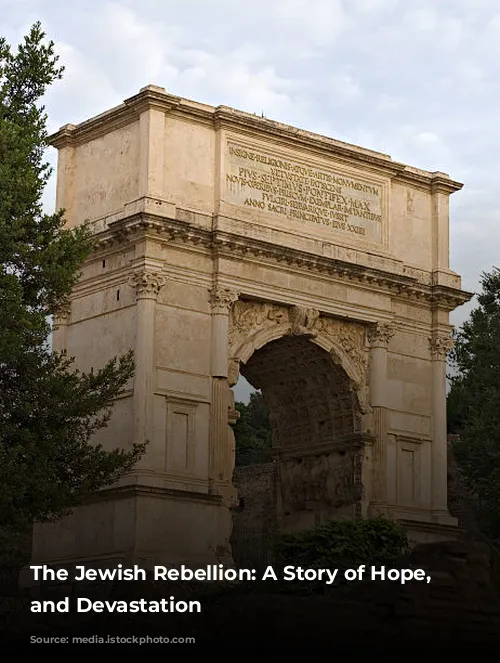
A Growing Conflict: The Flames of Rebellion Spread
In the months that followed, the conflict between the two factions raged. Brutal clashes erupted, leaving behind a trail of destruction and innocent victims.
The Roman response was swift and brutal. A Roman cohort of 600 soldiers, attempting to aid the beleaguered peace party, were mercilessly massacred after surrendering under promises of safe passage.
The flames of rebellion grew even more intense. Cestius Gallus, the governor of Syria, arrived with a large army to quell the unrest. He burned villages around Jerusalem as a chilling warning, but the rebels met him with fierce resistance, successfully repelling his forces.
The Roman Empire, known for its unwavering might, felt humiliated. Cestius Gallus, desperate to restore Roman authority, led his forces into Jerusalem. His aim: to besiege the city and capture the Temple, a sacred site for the Jews. However, in a moment of inexplicable hesitation, Cestius Gallus retreated from the city, leaving behind a trail of bewildered Romans and emboldened rebels.
The retreat was disastrous for the Romans. The rebels, energized by this unexpected turn of events, launched a ferocious counterattack, inflicting a heavy defeat on the Roman forces. Over 5,300 infantrymen and 480 cavalrymen were killed, along with precious artillery. The humiliation of the Roman Empire was complete.
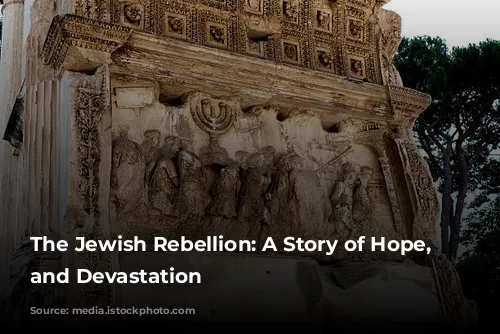
Rise and Fall of a Rebellious State: A Short-Lived Dream of Freedom
In the wake of this resounding victory, the moderate Jews fled Jerusalem. The city was now firmly in the hands of the war party. They established a new, independent state, boldly naming it Israel. This newfound independence was a beacon of hope for the Jewish people, a testament to their courage and resilience.
A tangible sign of their newfound sovereignty was the creation of their own coinage. These coins, minted with symbols of Jewish independence, were a powerful statement of defiance against the Roman Empire.
However, the dream of a unified, independent Israel was short-lived. Internal divisions and power struggles quickly crippled the fledgling state. The city became fractured, with competing factions vying for control. John, Simon, and Eleazar, three generals leading separate armies, battled for dominance, leaving Jerusalem in a state of perpetual chaos. The city was plagued by violence, murder, and the theft of wealth by the insurgents and the zealots.
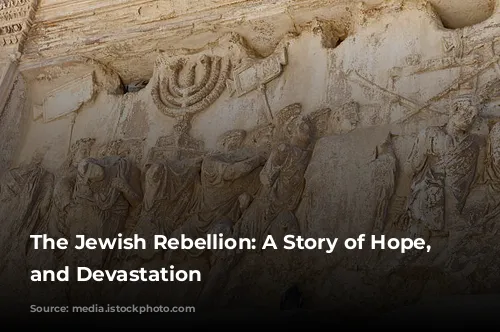
The Final Siege: A City and a People Broken
The Roman Empire was not willing to accept defeat. Emperor Nero appointed Titus Flavius Vespasianus, a skilled general, to crush the rebellion. Vespasianus, with an army of 60,000 men, gradually gained control of the countryside, leaving Jerusalem isolated and vulnerable.
The Jewish rebellion, which had lasted for five years, was about to reach its brutal conclusion. Titus, fueled by the desire for revenge, arrived in Jerusalem with an overwhelming force. He surrounded the city, trapping its inhabitants within its walls. Jerusalem was overflowing with people, as families from the surrounding villages had come to celebrate the Passover festival.
Titus’s strategy was simple: starve them into submission. He built a wall around the city, cutting off all supplies. The city, already ravaged by internal conflict, began to succumb to hunger. Josephus’s accounts of the famine are chilling, painting a picture of unimaginable suffering.
Despite the city’s desperation, Titus pressed his attack. He relentlessly assaulted the city’s defenses, using his superior weaponry, including catapults, ballista balls, and siege towers, to break through the walls. After days of relentless bombardment, the Roman forces finally breached the first line of defenses, forcing the Jewish rebels to retreat behind a second line of fortifications.
With the fall of the first wall, Titus believed the rebellion was all but over. He offered the rebels a chance to surrender, promising them safe passage and the preservation of the city and the temple. However, the Jewish rebels, fueled by a desperate hope for freedom, rejected the offer.
The siege continued, with the Roman forces determined to break the city’s will. After days of bloody fighting, the Roman forces finally captured the second wall, pushing the Jewish rebels into the heart of the city.
Even in the face of overwhelming odds, the Jewish rebels refused to surrender. They set fire to the Roman siege towers, causing significant damage. The Romans, however, were resourceful and quickly rebuilt their siege towers.
Despite the desperate resistance, the city’s fate was sealed. Titus, having witnessed the tenacity of the Jewish defense, decided to take the temple, the heart of Jewish faith, by force. He ordered his men to set fire to the temple gates, a symbolic act that marked the beginning of the end.
On the 9th of July, 70 AD, the anniversary of the destruction of the temple by the Babylonians in 586 BC, the Romans finally breached the temple. They fought their way into the inner sanctuary, slaughtering the remaining defenders. The city was in chaos, filled with the sounds of carnage and the smell of smoke and blood.
The following day, Titus unleashed his entire army on the remaining rebels. The massacre was brutal and indiscriminate. The city, once a symbol of Jewish faith and independence, was now a pile of rubble, its people decimated. The city was razed to the ground, a grim testament to the Roman Empire’s relentless pursuit of victory.
The Jewish rebellion was finally over. The Jewish people, once a thriving nation, were left broken and scattered. The destruction of Jerusalem, their sacred city, was a devastating blow to their spirit and their faith. The dream of independence, once so vibrant, had been extinguished in a sea of blood.
The events of 70 AD marked a turning point in Jewish history. The rebellion had failed, and the Jewish people were left to rebuild their lives, carrying the scars of their defeat and the memory of their lost homeland. The story of the Jewish rebellion is a tragic reminder of the cost of conflict, the fragility of hope, and the enduring power of faith.
